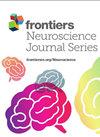前沿 | 经皮脊髓刺激可调节健康成年人的安静站立:刺激部位和认知方式很重要
IF 3.2
3区 医学
Q2 NEUROSCIENCES
引用次数: 0
摘要
该研究探讨了经皮脊髓电刺激(tES)对姿势控制的影响。受试者根据其认知风格被分为场依赖(FD)组和场非依赖(FI)组。场依赖型受试者使用外感知传入流进行空间定位,而场独立型受试者则使用内感知流。在黑暗中,FD 受试者通过头-躯干稳定来保持垂直姿势,而 FI 受试者则通过身体各部分的独立运动来保持垂直姿势。在此之前,我们曾研究发现,在 L1-L2 椎体水平施加 tES 会降低 FD 受试者的姿势稳定性。现在,我们在 T11-T12 椎体水平(中线,左或右背根上方)施加刺激。对 18 名 FD 和 FI 受试者的静态站立进行了稳定度评估。参与者在 tES 期间闭眼站立在隔音室的受力平台上。中线和左侧 tES 能明显改善 FD 参与者的姿势稳定性,改善幅度高达 28%,而 FI 参与者的姿势没有明显变化。T11-T12和L1-L2刺激效果之间的明显差异与腰部扩大的tES期间腿部近端和远端肌肉的选择性地形激活有关。这项研究强调了在姿势控制研究中考虑认知风格的重要性。本文章由计算机程序翻译,如有差异,请以英文原文为准。
Frontiers | Transcutaneous spinal cord stimulation modulates quiet standing in healthy adults: stimulation site and cognitive style matter
The study explored the effects of transcutaneous electrical spinal cord stimulation (tES) on postural control. Subjects were divided into field-dependent (FD) and field-independent (FI) groups according to their cognitive style. FD subjects use an exteroceptive afferent stream for spatial orientation, while FI subjects use an interoceptive stream. In darkness, vertical posture is maintained by head-trunk stabilization in FD subjects and by independent movements of body segments in FI subjects. Previously, we showed that tES at the L1-L2 vertebral level decreased postural stability in FD subjects. Now, stimulation was applied at the T11-T12 vertebral level (midline, above the left or right dorsal roots). Quiet standing was assessed using stabilometry in 18 FD and FI participants. Participants stood on a force platform in soundproof chamber with eyes closed during tES. Midline and left tES significantly improved postural stability by up to 28% in FD participants, while posture did not change significantly in FI participants. Pronounced differences between the effects of T11-T12 and L1-L2 stimulation are associated with selective topographical activation of proximal and distal leg muscles during tES of the lumbar enlargement. This study highlights the importance of considering cognitive style in postural control research.
求助全文
通过发布文献求助,成功后即可免费获取论文全文。
去求助
来源期刊

Frontiers in Neuroscience
NEUROSCIENCES-
CiteScore
6.20
自引率
4.70%
发文量
2070
审稿时长
14 weeks
期刊介绍:
Neural Technology is devoted to the convergence between neurobiology and quantum-, nano- and micro-sciences. In our vision, this interdisciplinary approach should go beyond the technological development of sophisticated methods and should contribute in generating a genuine change in our discipline.
 求助内容:
求助内容: 应助结果提醒方式:
应助结果提醒方式:


